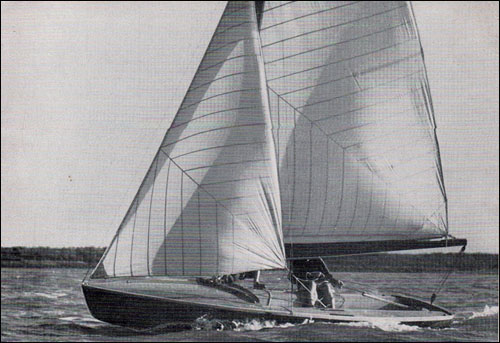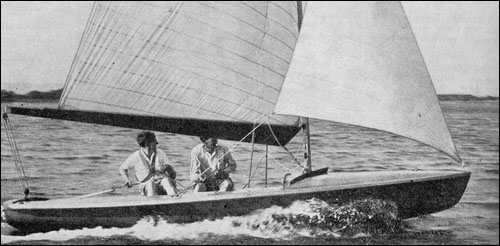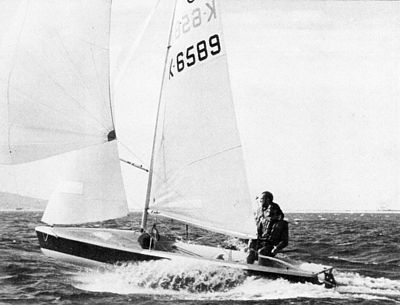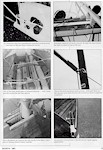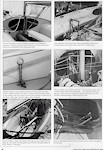|
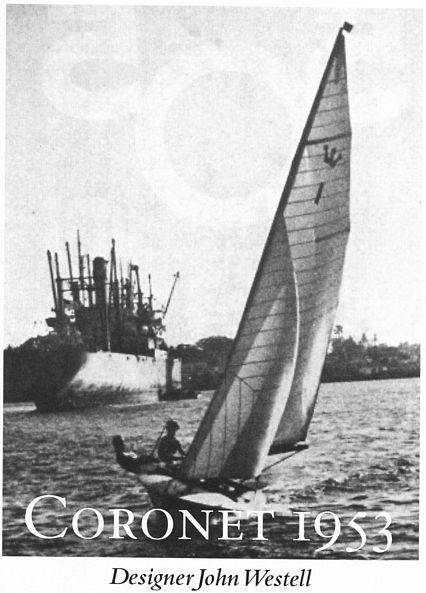 |
In 1953 the IYRU held trials to determine the best two man centreboard dinghy. The winner of the trials was Coronet, designed by John Westell. Westell was then asked by the French Caneton association to modify the boat to fit the existing Caneton rules. This was duly done by reducing the 18 foot hull and the sail area down to 150 square feet.
When the AGM met in January 1954 the new design was accepted and the 505 was born. The class has never looked back.
At first the boats were built in Britain and France. Later in 1954 the IYRU granted the class full international
status.
Although the class is strictly one design, latitude is allowed in the mast and centreboard position; in the rudder
and centreboard profile and section; and in the cockpit layout.
This has given rise to a number of innovations, some more successful than others. Indeed an ousider could be
forgiven a furrowed brow with terminology such as 'Loveday's loop' or 'Larry's bicycle', terminology more
appropriate to a model railway layout or a gymnasium.
During the evolution of the 505, fashion has dictated change. Early tastes favoured the mast bulkhead forward of the
mast. The question of gybing centreboards has now gone full circle as has the jib tack position. Some of the 1981
models have reverted to gybing boards, with the jib tack position as far forward as possible to allow the slot to
open upward in a blow.
An interesting facet of the class rules is that builders are free to choose their building materials. The first
boats were constructed in wood by Fairey Marine using the famous moulded double diagonal system. Both Parker and
Rondar now make GRP boats, particularly offering a composite construction. In these instances the decks can be made
using the 'West' epoxy system and the end result is a light boat popular in Europe and Scandinavia. Parker was the
first to experiment with carbon fibre and Kevlar construction. Construction with these more exotic materials has not
been without its problems. Unless one uses epoxy there are problems with either delamination or water absorbency. A
certain boat took its correctors out during the World Championship last year! Various types of stiffening have been used such as Nomex, a paper
honeycombe, Airex and end-grain balsa. Builders are once again going back to a foam laminate, particularly closed
cell which unlike Airex is more heat resistant and will not absorb water. Parker believes that this should add to
the life expectancy of the boat.
Stalwarts could argue that such a progressive attitude towards developments and changes leads to obsolence. For
instance there was not a boat in the first twenty under number 6000 at the 1980 Nationals. Indeed the oldest boat
finished 71 out of 75 entrants. The chances are that the 505 suffers the same problem as any other high performance
dinghy in that the quest for lighter and stiffer boats results in boats that 'age' quickly. Alternatively, others
find it more economic to buy a new boat rather than changing their existing boats.

Although there have been rigging changes such as the height of the trapeze and shroud wires, the Proctor D Section
is still very popular. John Loveday and Eddie Owen have each put in first rate performances using Needlespar and
Z-spar masts respectively. Over the years the height of the hounds moved up but the trend is now downards due to US
influences. Yet another major difference today is the lack of jib halyard. Some boats are now using strops with
tensioning devices and we have the emergence of the 'stuff luff' from the US, used with great effect by Steve
Benjamin.
Any class that wishes to survive needs personal impetus. There is no doubt that Terry Lawton has contributed a great
deal to the success of the class. 505 Great Britain, the UK class magazine will be ten years old next year, and
keeps the 505 owner in touch with all the latest news. There is even a definition of the '505 sailbag' being a lady
of many virtues... We are sure each class will have its own definition!
For those who are not quite so keen to punch the open meeting circuit there are several large fleets around the
country. Going back to my old days in 505s how decadent can one be owning a 505 on a student grant
– certain
regattas had a certain flavour, the Aleyard Trophy at Pitsford and the Hastings Open Meeting. Whilst the former
enabled some serious team racing to take place and the exchange of ideas at the end of the season, certain
participants were able to wash away the anguish of an early knockout with many a good glass of ale; the latter event
could provide some of the most exciting sea sailing in the UK. A new event in the 505 calendar is the European Cup,
competed for the first time in 1980. It is a series trophy, which involves travelling the European circuit. The
trophy was the brainchild of a certain Swiss gentleman who just happened to win it! Maybe he covered himself by
competing in all the events. David Pitman managed a creditable fourth place.
|
۞ Cinquo Retro Class ... just wood and a lot of passion ... ۞ The 5-Oh designed by John Westell, a yachting journalist and International 14 designer ۞ The John Westell Centenary ~ Introduction ۞ The John Westell Centenary ~ Part 1: The Early Years ۞
Top British Dinghy Of All Time, The Five-Oh-Five
— Sv.505 Förbundet — Uppdaterad
2021-01-15 |
